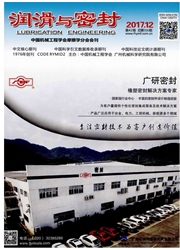

 中文摘要:
中文摘要:
对切削液油雾产生的机制进行理论分析,并对切削液油雾形成的影响因素进行实验研究。实验在密闭的车床内进行,利用车床的供液系统采用浇注式供给磨削液,在油雾产生密集区域内寒装有磨削液雾滴粒径的测量装置,该装置中的共聚焦显微镜可观察切削液雾滴在空气中的分布,精确扫描单颗雾滴的形态轮廓,通过计算机可计算出雾滴的分布和直径尺寸。分别控制主轴转速和切削液流量,探究对所形成的油雾浓度和平均直径的影响。实验结果表明:金属加工过程中主轴转速和切削液流量对切削液油雾特性的影响显著,随着主轴转速的增加,油雾的平均直径减小,而油雾浓度却呈上升趋势;随着切削液流量的增加,油雾的平均直径变大,并且油雾浓度同样呈上升趋势。
 英文摘要:
英文摘要:
A theory analysis was presented for the cutting fluid mist formation mechanisms, and the influencing factors on the cutting fluid mists formation were studied by relevant experiments. Experiments were conducted on the enclosed lathe, and the metal cutting fluid was supplied by pouring with the oil supply system of the lathe. A particle diameter measuring device was installed in the dense regions that cutting fluid mists were produced. The distribution of the cutting fluid droplets and the single droplets shape contour could be precise scanned by the Confocal Microscope, and the distribution of droplets and mean diameter size could be calculated through the computer. The effect of the influencing factors on the cutting fluid mist concentration and the mean diameter was investigated by controlling the spindle speed and cutting fluid flow rate respectively. The experimental results show that the cutting fluid mists characteristics is affected significant- ly by the spindle speed and cutting fluid flow rate in the machining process. The mean diameter of cutting fluid mists is reduced, and the concentration of droplets is increased along with the increasing of spindle speed. The mean diameter and the concentration of cutting fluid mists are increased along with the increasing of cutting fluid flow rate.
 同期刊论文项目
同期刊论文项目
 同项目期刊论文
同项目期刊论文
 The theoretical and experimental investigation into technological parameters of high-melting metal a
The theoretical and experimental investigation into technological parameters of high-melting metal a Analytical and experimental investigations into material removal mechanism of abrasive jet precision
Analytical and experimental investigations into material removal mechanism of abrasive jet precision Analysis of static and dynamic stiffness for coupled double-rotor spindle system of high speed grind
Analysis of static and dynamic stiffness for coupled double-rotor spindle system of high speed grind Evaluation of the dynamic characteristics of coupled double-rotor spindle system in high speed grind
Evaluation of the dynamic characteristics of coupled double-rotor spindle system in high speed grind Modeling and Experimental Investigation of Pressure Field in the Grinding Zone with Nanoparticle Jet
Modeling and Experimental Investigation of Pressure Field in the Grinding Zone with Nanoparticle Jet Investigation into Engineering Ceramics Grinding Mechanism and the Influential Factors of the Grindi
Investigation into Engineering Ceramics Grinding Mechanism and the Influential Factors of the Grindi Modeling the operation of a common grinding wheel with nanoparticle jet flow minimal quantity lubric
Modeling the operation of a common grinding wheel with nanoparticle jet flow minimal quantity lubric Experimental Verification of Nano-Particle Jet Minimum Quantity Lubrication Effectiveness in Grindin
Experimental Verification of Nano-Particle Jet Minimum Quantity Lubrication Effectiveness in Grindin Simulation Study on Effect of Cutting Parameters and Cooling Mode on Bone-drilling Temperature Field
Simulation Study on Effect of Cutting Parameters and Cooling Mode on Bone-drilling Temperature Field Experimental Evaluation of the Lubrication Performance of MoS2/CNT Nanofluid for Minimal Quantity Lu
Experimental Evaluation of the Lubrication Performance of MoS2/CNT Nanofluid for Minimal Quantity Lu Technological Investigation about Minimum Quantity Lubrication Grinding Metallic Material with Nanof
Technological Investigation about Minimum Quantity Lubrication Grinding Metallic Material with Nanof Investigation into the Formation Mechanism and Distribution Characteristics of Suspended Micropartic
Investigation into the Formation Mechanism and Distribution Characteristics of Suspended Micropartic Experimental Study on Generation Mechanism and Influencing Factors of Metal Machining Fluid Oil Mist
Experimental Study on Generation Mechanism and Influencing Factors of Metal Machining Fluid Oil Mist Investigation on the Grinding Temperature Field of Nano-ZrO2 Dental Ceramics with a Nanoparticle Jet
Investigation on the Grinding Temperature Field of Nano-ZrO2 Dental Ceramics with a Nanoparticle Jet Modeling and Simulation of the Single Grain Grinding Process of the Nano-particle Jet Flow of Minima
Modeling and Simulation of the Single Grain Grinding Process of the Nano-particle Jet Flow of Minima Experimental research on the energy ratio coefficient and specific grinding energy in nanoparticle j
Experimental research on the energy ratio coefficient and specific grinding energy in nanoparticle j 期刊信息
期刊信息
